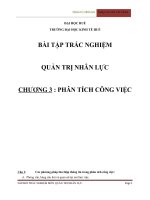Chap020 TRẮC NGHIỆM QUẢN TRỊ TÀI CHÍNH BẰNG TIẾNG ANH
Bạn đang xem bản rút gọn của tài liệu. Xem và tải ngay bản đầy đủ của tài liệu tại đây (54.98 KB, 22 trang )
Chapter 20
Credit and Inventory Management
Multiple Choice Questions
1.
Blackwell Brothers sells men's suits. The store offers a 1 percent
discount if payment is received within 10 days. Otherwise, payment
is due within 30 days. This credit offering is referred to as the:
A. terms of
sale.
B. credit
analysis.
C. collection
policy.
D. payables
policy.
E. collection
float.
Refer to section 20.1
AACSB: Analytic
Blooms: Remember
Difficulty: 1 Easy
Learning Objective: 20-01 How firms manage their receivables and the basic components of a firm's credit
policies.
Section: 20.1
Topic: Terms of sale
2.
Jillian was recently hired by a major retail store. Her job is to
determine the probability that individual customers will fail to pay for
their charge sales. Jillian's job best relates to which one of the
following?
A. terms of
sale
B. credit
analysis
C. collection
policy
D. payables
policy
E. customer
service
Refer to section 20.1
3.
Town Hardware sells goods on credit with payment due 30 days after
purchase. If payment is not received by the 30th day, the store mails
a friendly reminder to the customer. If payment is not received by the
45th day, the store calls the customer and requests payment and also
stops offering credit to that customer. These procedures are referred
to as the store's:
A. customer service
policy.
B. credit
policy.
C. collection
policy.
D. payables
policy.
E. disbursements
policy.
Refer to section 20.1
4.
Phil's Print Shop grants its customers the right to pay for their print
jobs within 30 days of the date of service. This 30-day period is
referred to as the:
A. payables
period.
B. cash
cycle.
C. transactions
period.
D. credit
period.
E. disbursement
period.
Refer to section 20.2
AACSB: Analytic
Blooms: Remember
Difficulty: 1 Easy
Learning Objective: 20-01 How firms manage their receivables and the basic components of a firm's credit
policies.
Section: 20.2
Topic: Credit period
5.
Scott purchased a shovel, a rake, and a wheelbarrow from The Local
Hardware Store yesterday. Today, the store issued a bill for these
items and mailed it to Scott. What is the name given to this bill?
A. ledger
statement
B. warran
ty
C. indentu
re
D. recei
pt
E. invoic
e
Refer to section 20.2
6.
Geoff Industries offers its credit customers a 2 percent discount if
they pay within 10 days. This discount is referred to as a:
A. cash
discount.
B. purchase
discount.
C. collection
discount.
D. market
discount.
E. receivables
discount.
Refer to section 20.2
7.
The basic factors to be evaluated in the credit evaluation process, the
five Cs of credit, are:
A. conditions, control, cessation, capital, and
capacity.
B. conditions, character, capital, control, and
capacity.
C. capital, collateral, control, character, and
capacity.
D. character, capacity, control, cessation, and
collateral.
E. character, capacity, capital, collateral, and
conditions.
Refer to section 20.5
8.
Which one of the following is a system for managing demanddependent inventories that minimizes the inventory levels of a firm?
A. just-in-time
inventory
B. turnover
planning
C. net working capital
planning
D. inventory
scoring
E. inventory
ranking
Refer to section 20.8
9.
What is the primary purpose of credit analysis?
A. determine the optimal credit
period
B. establish the effectiveness of granting a cash
discount
C. determine the optimal discount period,
if any
D. access the frequency and amount of sales by
customer
E. evaluate whether or not a customer
will pay
Refer to section 20.1
10.
The period of time that extends from the day a credit sale is made
until the day the bank credits a firm's account with the payment for
that sale is known as the _____ period.
A. floa
t
B. cash
collection
C. sale
s
D. accounts
receivable
E. discou
nt
Refer to section 20.1
11.
Which one of the following factors tends to favor longer credit
periods?
A. high consumer
demand
B. lower priced
merchandise
C. increased credit
risk
D. merchandise with low collateral
value
E. increased
competition
Refer to section 20.2
12.
Which one of the following credit instruments is commonly used in
international commerce?
A. open
account
B. sight
draft
C. time
draft
D. banker's
acceptance
E. promissory
note
Refer to section 20.2
13.
When evaluating the creditworthiness of a customer, the term
character refers to the:
A. nature of the cash flows of the customer's
business.
B. customer's financial
resources.
C. types of assets the customer wants to pledge as
collateral.
D. customer's willingness to pay bills in a timely
fashion.
E. nature of the customer's line of
work.
Refer to section 20.5









